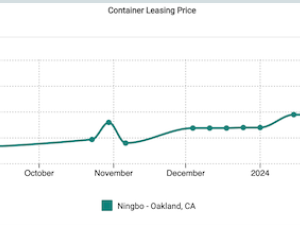Hapag-Lloyd, UASC said to plan merger to beat shipping crisis
By: Nicholas Brautlecht | Apr 21 2016 at 06:25 AM | Liner Shipping
Hapag-Lloyd AG, the German container shipping line that counts billionaire Klaus-Michael Kuehne as one of its biggest shareholders, is in merger talks with Middle Eastern competitor United Arab Shipping Co. as they grapple with dwindling freight prices in a consolidating industry, according to a person familiar with the discussions.
The plans may be made public as soon as Thursday, said the person, who declined to be identified as the talks are private. Manager Magazin reported the discussions earlier. Hapag-Lloyd, based in Hamburg, declined to comment on the report. The shares surged 13 percent to trade at 18.45 euros as of 12:11 a.m. in Frankfurt, rising to the highest level since January.
A merger would give Hapag-Lloyd immediate access to some of the largest container ships available as UASC has six ships with a capacity of 18,800 standard 20-foot containers, a size the Hamburg carrier so far lacks and which is key to operating on Asia-Europe trade routes. The combined company would rank fifth in the industry dominated by the Danish shipping giant A.P. Moeller-Maersk A/S, according to calculations based on data by trade publication Alphaliner on operated fleets as of Thursday.
“Hapag-Lloyd so far shied away from ordering the biggest vessels though stakeholder Kuehne has pushed publicly in that direction,” Oliver Drebing, an analyst at Hamburg-based Alsterresearch, said in an e-mail. “If the merger works out, Hapag-Lloyd would no longer have to make the decision to order bigger ships.”
Industry Crisis
Shipping lines have sought safety in numbers as they struggle to emerge from a crisis now in its eighth year. Once the world No. 4, following its 2014 merger with the container-shipping operations of Valparaiso, Chile-based Cia. Sud Americana de Vapores SA, Hapag-Lloyd has slipped back to sixth place in the past two years. CMA CGM SA’s takeover of Singapore’s Neptune Orient Lines Ltd. and the combination of China Cosco Holdings Co. and China Shipping Container Lines, both announced in December, have cemented CMA’s position as No. 3 and pushed Cosco into fourth place.
“A merger would be a positive step for Hapag-Lloyd, as size matters in that highly competitive industry,” Thomas Wybierek, a shipping analyst at NordLB, said by e-mail. “Hapag-Lloyd’s experience from the CSAV merger should create positive tailwinds for the next combination, even though the Chilean transaction was relatively recent and not all synergies have been finalized.”
Shareholder Kuehne, who holds about one-fifth of Hapag-Lloyd shares, has repeatedly said the Hamburg carrier needs to grow further through acquisitions or mergers to stay competitive. Chief Executive Officer Rolf Habben-Jansen, who took the helm in July 2014, said on March 23 the company may pursue further combinations if opportunities arise.






